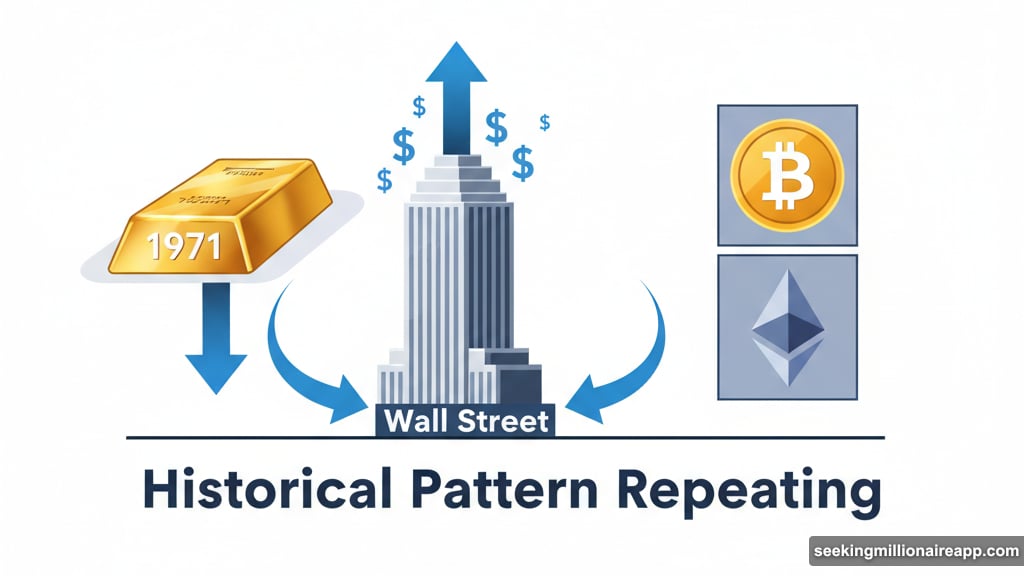Tom Lee just made a bold call. Ethereum might overtake Bitcoin the same way Wall Street replaced gold as the center of global finance.
Sounds crazy? Maybe. But his reasoning makes more sense than you’d think. Plus, the data backs him up in surprising ways.
Lee runs Fundstrat and chairs BitMine Technologies. So he’s not some random crypto bro throwing out price predictions. He’s watching historical patterns repeat themselves in real time.
The 1971 Playbook Playing Out Again
Lee points to a specific moment in financial history. In 1971, the US ditched the gold standard. Everyone expected gold to dominate as investors panicked about the dollar losing its anchor.
Instead, Wall Street won. Investment banks created money market funds, mortgage-backed securities, and complex financial products that made the dollar more powerful than ever. Gold stayed valuable. But it became a sideshow while equities and dollar-based assets exploded.
The numbers tell the story. Dollar dominance surged from 27% of global GDP to 57% of central bank reserves. Plus, 80% of financial transactions got quoted in dollars. Gold couldn’t compete with that kind of innovation and utility.
Now Lee sees the same pattern emerging in crypto. Bitcoin plays the role of digital gold—pristine, scarce, unchanging. Meanwhile, Ethereum becomes the platform where actual financial infrastructure gets built.
Tokenization Changes Everything
Here’s where it gets interesting. Everything’s moving onto blockchains now. Not just digital currencies, but stocks, real estate, bonds—basically every financial asset you can imagine.
Stablecoins already put dollars on-chain. That’s just the beginning. Companies will tokenize equity. Real estate will trade as programmable assets. Traditional finance products will migrate to smart contracts.
Bitcoin can’t host any of that. It’s designed to be money, period. Ethereum, on the other hand, was built specifically for these use cases. So as tokenization accelerates, Ethereum captures the growth while Bitcoin stays in its lane.
Lee projects this dynamic could push ETH to $60,000 by 2030. That’s a 1,510% gain from today’s $3,727 price. Bold? Absolutely. But he’s not pulling numbers from thin air.

For comparison, he sees Bitcoin hitting $1.5 million to $2.1 million in the same timeframe. Still bullish on both. But the Ethereum growth rate tells you where he thinks the real action happens.
Developers Vote With Their Code
Want proof Ethereum’s winning the infrastructure race? Look at developer activity. Between January and September 2025, Ethereum attracted 16,181 new developers.
Bitcoin? Just 7,494. That’s less than half. Even Solana, which gets hyped constantly, only pulled in 11,534 developers.
The Ethereum Foundation said it plainly: “By a wide margin, developers new to crypto prefer the Ethereum ecosystem.” When builders choose where to spend their time, they pick Ethereum overwhelmingly.
This matters more than people realize. Developers create the applications, protocols, and financial products that drive real usage. Bitcoin’s developer community focuses on security and stability—critical work, but narrow in scope.
Ethereum’s developers build DeFi protocols, tokenization platforms, NFT marketplaces, gaming economies, and identity systems. That breadth attracts more talent, which creates more innovation, which brings more users. The flywheel spins faster.
Short-Term Targets Look Aggressive Too
Lee isn’t just talking about 2030. He projects Bitcoin reaching $200,000 by the end of 2025. That’s roughly double the current price around $100,000.
For Ethereum, he expects $10,000 to $12,000 in the same period. Currently trading at $3,727, that represents a 168% to 222% gain in under a year.
Those near-term forecasts suggest he sees momentum building fast. Not just slow, steady growth toward those 2030 targets. Something significant happens sooner.
What could drive that? Institutional adoption of tokenized assets seems like the obvious catalyst. Major financial institutions already announced plans to put traditional securities on blockchain. When that starts happening at scale, Ethereum’s the infrastructure it runs on.

The Working Theory Has Holes
Lee himself calls this a “working theory.” Smart move. Because the flip scenario isn’t guaranteed by any stretch.
Bitcoin’s network effects remain massive. It’s the most recognized crypto brand globally. Security-focused investors won’t abandon it for something more complex and experimental. Plus, Bitcoin’s simplicity becomes an advantage when regulators get involved.
Ethereum faces real technical challenges too. Gas fees spike during high usage. Scaling solutions help but add complexity. Competing smart contract platforms keep improving. The network needs to maintain its lead while solving these problems.
Market cap gaps matter as well. Bitcoin sits around $2 trillion in total value. Ethereum hovers near $450 billion. Closing that gap requires sustained outperformance for years, not months.
So yeah, Ethereum could flip Bitcoin. But could isn’t the same as will.
Why This Comparison Works
The Wall Street versus gold analogy hits differently when you think about it. Gold didn’t fail after 1971. It still exists. People still buy it as insurance against uncertainty.
But it stopped being the center of the financial system. Innovation moved elsewhere. The dynamic instruments built on top of the dollar created more value and utility than static gold ever could.
Bitcoin might follow the same path. It remains valuable as digital gold. Institutions hold it. Individuals accumulate it. But the financial innovation happens on Ethereum and similar platforms.
That doesn’t make Bitcoin worthless. Far from it. But it shifts the growth story. Bitcoin becomes the foundational asset. Ethereum becomes where stuff actually happens.
Lee’s not saying abandon Bitcoin. He’s saying Ethereum might capture more of the upside as crypto integrates with traditional finance. That’s a subtle but important distinction.
The developer data supports this view. Builders go where they see opportunities. Right now, overwhelmingly, that means Ethereum. Whether that translates to market cap dominance remains the open question.
